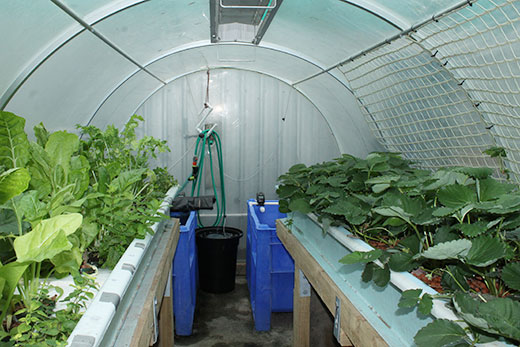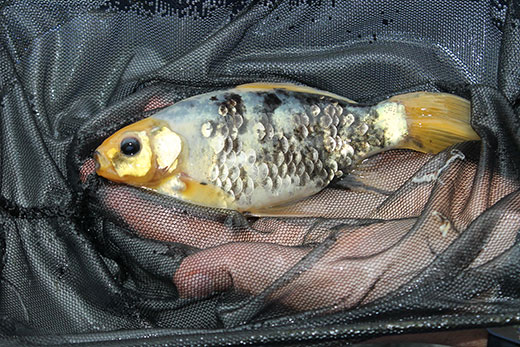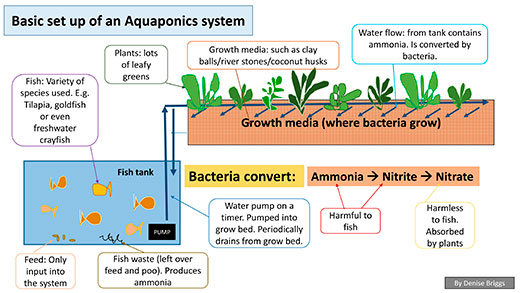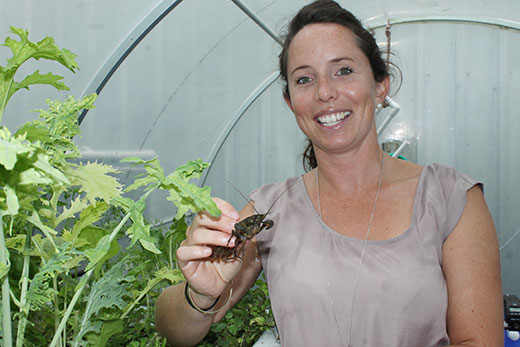Fish fertiliser is well recognised as a great plant food but at the Bay of Plenty Polytech live – not dead – fish are fertilising plants which return the favour by improving the water quality in their tanks.
Tutor and researcher Denise Briggs has established an aquaponics system in a small shade-house growing strawberries and a range of leafy vegetables and herbs, with the help of two tanks each containing about six goldfish.
“However, they are inclined to escape and fight each other so we have to keep them in separate cages under water.”
The aquaponics system in a small shade house at the polytechnic.
“Aquaponics offer such exciting possibilities, especially to help provide food security for nations without much fertile land or those with harsh growing conditions,” says Denise, who has been experimenting with aquaponics at the polytechnic for about two years.
The flexibility and relative simplicity of aquaponics appeals to Denise, who says home owners can build small units in their backyard and produce both vegetables and protein.
On a larger scale the system could feed a village and be big enough to provide income from selling fish and vegetables. Or it can be upscaled to commercial operations.
The concept is rapidly gaining popularity worldwide. “In Detroit and New York, and in Berlin people are setting up aquaponic systems in unused buildings or small warehouses.
“In Australia a group of scientists are using a solar-powered desalination plant to provide water for an aquaponics system, which is growing tomatoes in the desert.”
Added benefits
As the name suggests, aquaponics is the ‘marriage’ of aquaculture and hydroponics, with added benefits.
With hydroponics, plants grow in circulating water enriched with nutrients. In aquaculture, snails, shellfish, crayfish, prawns and fish are raised in tanks, with water needing constant changing or filtering because of toxicity caused by excretions.
The beauty of aquaponics is that tank water circulated to plants provides them with nutrients and their roots filter the water, improving its quality when it’s returned to the fish tank.
“Once the system is working properly, you never need to replace the water – although it does need topping up because of evaporation and transpiration.”
“It’s estimated an aquaponics system uses one to 10 per cent of the water in terrestrial-based systems for growing vegetables.”
One of the goldfish the aquaponics system supports.
Year-round food
Systems don’t have to be indoors but because the plants aren’t rooted in soil, some form of wind protection is required. An aquaponics system set up in a greenhouse could provide out-of-season food year-round.
The system at the polytechnic consists of two high benches holding long, relatively shallow tanks.
On one side vegetables including lettuce, silverbeet and herbs grow in pots filled with medium such as bark.
On the opposite bench strawberries grow in a medium of small clay balls. Both media provide the habitat for bacteria essential to help the plants access nutrients in the water, which flows through their roots.
“Water is pumped from the fish tanks every three hours to flood the roots, then drained back into the tanks. It is important the roots are not constantly saturated in water or else they will rot.”
The ideal ration of fish to plants is dependent on the type of plants growing and the species of fish used.
The fish are fed with an organic food, which Denise and her students have developed. “It has to be organic, with no artificial additives because they could kill the plants.”
In turn, no sprays are used on the plants, as they pose a risk to the fish.
Koura experiment
While it’s goldfish which are currently feeding the plants, they’re not a suitable edible species so Denise is experimenting with koura, New Zealand’s freshwater crayfish.
“We have been working with the iwi at McLaren Falls near Tauranga and have permission to take some koura from there. We’ve been experimenting on making food for them, including pellets made from soya beans.
Koura grow to a good size and come in a range of colours which commercially could have appeal to Asian markets.
Freshwater shellfish are also being trailed, and Denise has them placed, not in the fish tank, but under the plants. Overseas tilapia freshwater fish are used in an aquaponics system.
“These are ideal because they are relatively easy to raise, have a delicate white flesh and are well-known throughout the world, especially in Asia and the USA. McDonalds has used tilapia in its fish burgers.
“However, because of our strict biosecurity standards, we’re not allowed to import them to New Zealand – even though it’s unlikely they would survive should they escape into our waterways because they can’t live in water cooler than 21 degrees Celsius.”
Trout out
Denise says trout would be the ideal commercial aquaponics species in New Zealand but currently Fish & Game has exclusive rights for raising trout.
New Zealand’s native freshwater fish are too small to be economically viable and while eels are another possibility, rules around taking them from the wild are getting tougher and they are very hard to contain, says Denise.
“Eels are great at escaping. You pretty much need an electric fence around a tank to keep them in.”
When Denise decided to study marine biology in Newcastle as an undergraduate and complete a Masters in aquaculture at Swansea, she never expected it would lead her to growing vegetables.
“I do like to garden at home but I know very little about plant biology but plenty about the biology of fish, which is why it’s great to have the horticultural team here at the polytech.”
Denise had an adventurous childhood travelling the world with her parents. “My father was with the Gurkhas, a famous part of the British Army made up of soldiers from Nepal. Later he became a sugar and coco trader in West Africa.”
When she left home Denise travelled extensively competing semi-professionally and teaching windsurfing in between university studies.
Pacific Islands
“I had heard what a wonderful place New Zealand was, with an ethos of sustainability, so decided to come here.” Her first position was with NIWA at its Bream Bay aquaculture research centre in Northland. Then three years ago, she took up her current role as a member of the Bay of Plenty Polytechnic’s marine studies academic and teaching staff.
“Having lived in Africa I can see the opportunities aquaponics could offer people for who food security is becoming an increasingly pressing issue.
“It also has great potential for Pacific Island nations, especially where there is limited fertile ground for growing vegetables and reefs are in danger of being over-fished.”
The aquaponics system at the polytech is an important teaching resource for students but also a working experiment designed to help establish the best aquatic food species to use in New Zealand, as well as develop food for the fish or koura and discover what range of plants will grow well.
For more information about aquaponics, search the internet or email Denise Briggs at Denise.Briggs@boppoly.ac.nz



0 Comments
Leave a Comment